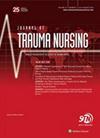全血计划:在农村创伤中心实施。
IF 0.9
4区 医学
Q4 CRITICAL CARE MEDICINE
引用次数: 0
摘要
背景均衡输注血液成分在创伤止血复苏中发挥着重要作用。本研究是一项非随机、回顾性、观察性的单中心研究,针对一家二级创伤中心 2020 年至 2022 年实施的成人大量输血冷藏全血计划。创伤登记数据确定了该机构的全血需求,促进了可持续的血液供应。制定了全血使用协议,每月在利益相关者和创伤服务会议上对不相容 ABO 抗体溶血的使用情况和实验室合规性进行监测和审查。结果从 2018 年到 2019 年,该机构每 9 天启动一次成分治疗大量输血(n = 41)。因此,确定每两周提供 4 个单位的低滴度 O 型阳性全血,以覆盖患者并最大限度地减少浪费。在整个研究期间(2020-2022 年),共有 68 名血流动力学不稳定的患者,其中接受全血治疗的患者为 37 人,接受成分治疗的患者为 31 人。与只接受成分治疗的患者(9 人,29%)相比,全血患者(3 人,8%)的死亡率明显较低(P = 0.030)。对损耗率进行了持续评估;2021 年,43.4% 的血液未被使用,2022 年,损耗率降至 38.7%。据说,护士们对输注全血的管理和记录的简便性表示赞赏,因为它否定了比例合规性。本文章由计算机程序翻译,如有差异,请以英文原文为准。
Whole Blood Program: Implementation in a Rural Trauma Center.
BACKGROUND
The balanced transfusion of blood components plays a leading role in traumatic hemostatic resuscitation. Yet, previous whole blood studies have only focused on urban trauma center settings.
OBJECTIVE
To compare component vs whole blood therapy on wastage rates and mortality in the rural setting.
METHODS
This study was a nonrandomized, retrospective, observational, single-center study on a cold-stored whole blood program implementation for adult massive transfusions from 2020 to 2022 at a Level II trauma center. Trauma registry data determined the facility's whole blood needs and facilitated sustainable blood supplies. Whole blood use protocols were established, and utilization and laboratory compliance for incompatible ABO antibody hemolysis was monitored and reviewed monthly at stakeholder and trauma services meetings.
RESULTS
From 2018 to 2019, the facility initiated component therapy massive transfusions every 9 days (n = 41). Therefore, four units of low-titer, O-positive whole blood delivered fortnightly was determined to provide patient coverage and minimize wastage. Across the study time frame (2020-2022), there were n = 68 hemodynamically unstable patients, consisting of those receiving whole blood, n = 37, and patients receiving component therapy, n = 31. Mortality rates were significantly lower (p = .030) in the whole blood population (n = 3, 8%) compared to those solely receiving component therapy (n = 9, 29%). Wastage rates were constantly evaluated; in 2021, 43.4% was not utilized, and in 2022, this was reduced to 38.7%. Anecdotally, nurses appreciated the ease of administration and documentation of transfusing whole blood, as it negated ratio compliance.
CONCLUSION
This evidence-based whole blood program provides vital care to severely injured trauma patients in a vast, rural region.
求助全文
通过发布文献求助,成功后即可免费获取论文全文。
去求助
来源期刊

Journal of Trauma Nursing
CRITICAL CARE MEDICINENURSING&-NURSING
CiteScore
1.20
自引率
10.00%
发文量
106
期刊介绍:
Journal of Trauma Nursing (JTN) is the official journal of the Society of Trauma Nurses.
The Society of Trauma Nurses believes that trauma is a disease impacting patients through the continuum of care. The mission of STN is to ensure optimal trauma care through education, collaboration, leadership and membership engagement. As the official publication of the Society of Trauma Nurses, the Journal of Trauma Nursing supports the STN’s strategic goals of effective communication, education and patient advocacy with original, peer-reviewed, research and evidence-based articles and information that reflect the highest standard of collaborative care for trauma patients.
The Journal of Trauma Nursing, through a commitment to editorial excellence, implements STN’s vision to improve practice and patient outcomes and to become the premiere global nursing organization across the trauma continuum.
 求助内容:
求助内容: 应助结果提醒方式:
应助结果提醒方式:


